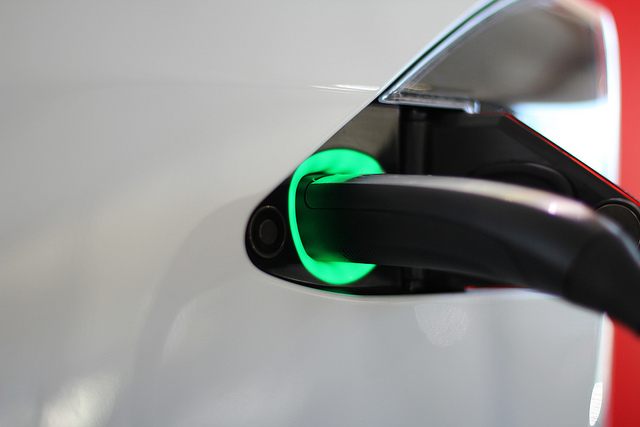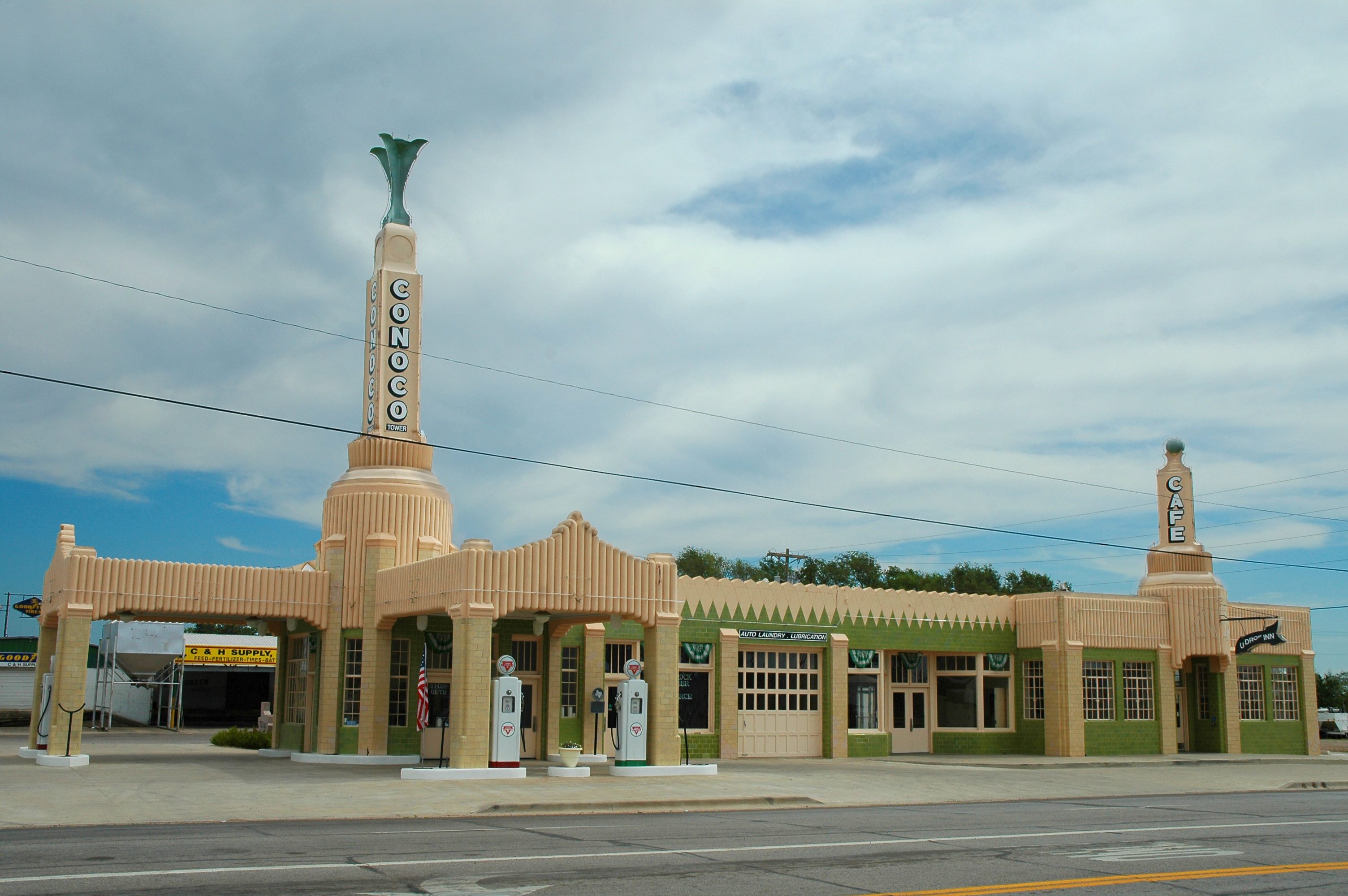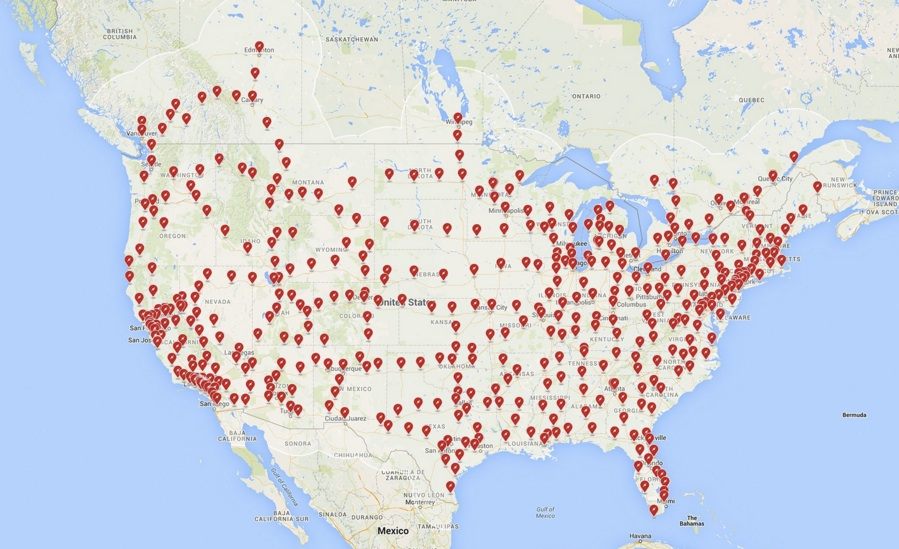America’s Massive New Transportation Infrastructure System is Hiding in Plain Sight

A Tesla Model S (Photo: Maurizio Pesce/flickr)
On a Saturday in early January 2016, dozens of Teslas started pulling into a parking lot in Denton, Texas, on the north edge of Dallas, for a ribbon-cutting ceremony that’d been a year in the making. It had started off as a small, unofficial, affair, but for Denton, becoming part of the “Supercharger highway” was a big enough moment that the mayor decided to show up.
“We had to get serious,” says Rick Bollar, a Tesla owner who helped organize the ceremony.
To most people, the spot wouldn’t look like anything special. It’s off a major highway, in a shopping center with a Panera, a fro-yo spot, and a few other diversions. But Tesla owners track lots like this one with a fervor, even as Tesla tries to keep their development secret. They are the ideal locations for fast-charging stations—Superchargers, Tesla calls them—specialized outlets that make long-distance travel in electric vehicles close to effortless.
For Tesla owners in Texas, this parking lot had become a key destination, a launching point that would allow them to make it from their current, Texas-centric network of Superchargers to the more extensive system that’s spreading quickly across the country.
Not that long ago, when a new Supercharger station opened up, Tesla Motors would hold these ribbon-cutting ceremonies. But the North Texas group had organized this one themselves; Supercharger stations are opening up at such a fast pace that the company can’t fête them all. For Tesla owners, though, a new one is still a cause for celebration, because each station can represent a major shift in how they can use their cars—by charging the battery in 20-30 minutes, these stations made it possible for electric vehicle owners to travel further and faster than they ever could before.

A Tesla Model S charging up (Photo: Joseph Thornton/flickr)
For most of their history, electric vehicles have had little romance to them. They could promise to cover the ground of daily routines. Drive to work. Drive to the store. Drive to meet friends. Drive home. An electric car could take you down familiar roads, but they couldn’t escape. Zoom out of town, on whatever road promised release–and an EV could take you only so far before it needed hours to recharge.
Now, though, car companies are rapidly building a whole new system of infrastructure, which could one day replace the network of gas stations that have supported car travel for the past 100 years. Three year ago, Tesla had only a handful of Superchargers in place; today there are more than 270. Rival car companies are spooling out their own networks of fast-charging stations, too. By the end of the year, Tesla promises, its drivers will be able to use the Supercharger network to drive through every state in the continental U.S.
In March, Tesla has promised to unveil its Model 3, which, at $35,000, will be the first Tesla that’s not ridiculously expensive. But perhaps more importantly, because of Tesla’s charger network, it’ll be the first one that will require no compromise from owners on how far their car might take them.

The Shamrock, Tx., U-Drop Inn had a Supercharger installed in 2014 (Photo: Clinton Steeds/Wikimedia)
There’s little consensus about where, exactly, the first gas station in America opened. In the first years of the 20th century, when cars were becoming more common, drivers would stop at blacksmiths and pharmacies, where fuel would be siphoned from a barrel out back and delivered in cans to the car. In 1905, a gas station opened in St. Louis and in 1907, one in Seattle—both have been identified as the first dedicated stations.
But they were simple affairs. The first drive-in gas station, the one that’s widely recognized as the start of gas station proliferation, was opened by Gulf Oil, in 1913, in Pittsburgh, Pennsylvania. It came complete with a pagoda-like awning, free maps, and well-dressed attendants to spiff up customers’ cars.
By 1920, according to The Gas Station in America, the country had 15,000 gas stations; by the end of the decade, there were 200,000. Most were independent outfits who contracted their gas from big oil companies, but among the most successful were the stations companies built themselves to sell their particular brand of gas to the nation’s new drivers.
In some ways, though, constructing a new system for charging cars is easier than moving gasoline around the country. The electric grid reaches most places already in the U.S., and with the right plug, electric cars can be charged at the same household outlets that power phones, lights, computers, and the rest of our electronic gadgets. That charge will just be painfully slow (think close to 24 hours for a full charge). Tesla’s Superchargers, on the other hand, can charge the company’s Model S battery more than half full in about 30 minutes.*
The Model S ranks lower than the much-cheaper Nissan Leaf (whose range is less than 100 miles per charge) in overall all-time sales, it’s gaining: it was the best-selling electric vehicle in the country last year. All the cars are bound by the same laws of physics, though, which determine how quickly electricity can be transferred to their batteries. There are tiered levels of charging, each of which delivers electricity faster than the last, and most electric cars use the same monster plugs to connect to higher-level chargers built to a universal standard. Tesla, though, developed its own proprietary plug and chargers, the Superchargers. They are free for Tesla Model S and Model X owners to use, and they are faster than any other charger out there right now.

A Tesla Supercharger station in Georgia (Photo: Michael Rivera/Wikimedia)
Some Superchargers, like the Shamrock, Texas, station, which is housed in a restored Conoco gas station, are particularly stylish. But, at a minimum, Tesla tries to locate them at places where drivers can eat, get online and use the bathroom while their car charges. Drivers might wave to each other if they’re charging at the same time, or they might strike up a conversation, about their cars, where they came from, or where they’re headed.
There are almost never lines, although when there are, they are serious lines–on a holiday weekend in December 2015, one popular California Supercharger station built up a line 18 cars long, which meant some drivers waited for more than two hours before they could head out again. A more common problem is getting “ICE’d”, which is what Tesla owners call it when a car with an internal combustion engine (or ICE) parks in an electric vehicle spot and blocks the Supercharger.
Tesla’s first stations, in place by the end of 2012, were in California and along the Northeast’s I-95 corridor from Boston to Washington. In 2013, the company promised to have Superchargers available to power trips along both coasts and across the country by the end of the year, and in January 2014, a Tesla team demonstrated their success by using the new network to drive from Los Angeles to New York faster than any electric vehicle had before (although that record was soon bested–in another Tesla).
Now, Superchargers cover routes that crisscross the country. They go from San Diego to Vancouver and east to Alberta. They go through Arizona and New Mexico in the southwest. In the east, the network stretches from Florida, across the Gulf Coast to Texas, up to Maine, Michigan and Minnesota. There are cross-country routes that pass through Montana and South Dakota in the north, and Nevada, Utah, Colorado, Kansas, and Missouri in the middle. Right now, California has the most chargers, 41, followed by Florida, with 14; only four states of the lower 48 (North Dakota, Nebraska, Arkansas and Mississippi) have none.

The BMW i3, a rival electric vehicle (Photo: Kārlis Dambrāns/flickr)
For most drivers, the rapid expansion of this network and of other EV infrastructure has happened unobtrusively, almost invisibly. Perhaps the driver of a regular old ICE vehicle might have noticed a few public parking spots reserved for electric cars, or become accustomed to seeing Teslas stop at a Supercharger in their small, conveniently located town.
The scope of this new infrastructure system and the speed of its growth, though, are dizzying. Even the obsessive Tesla owners who pay close attention to the network have to hunt down the locations of new stations, if they want to track where, exactly, Tesla is expanding its reach.
Tesla is secretive about the process for siting its Supercharger stations. The company will release maps that hint how the network will expand, but the exact locations are fuzzy at best and promised locations don’t always materialize in the time frame promised. Even when construction has begun at new stations, the company may not officially acknowledge them, and Tesla owners have been asked not to take pictures at these sites. It’s not clear if it’s the company itself making that rule or if contracted construction companies don’t want the scrutiny, but one widely shared video that a contractor posted of a site going up in 2014 has since disappeared from YouTube. (Atlas Obscura reached out to Tesla multiple times with questions about the Supercharger network and received no response.)

The Supercharger network that Tesla envisions for 2016 (Image: Tesla Motors)
There are good reasons for Tesla to keep its Supercharger locations under wraps. Every single station is a small negotiation of local parking regulations and land use laws, and sometimes Supercharger construction can get held up for months while the company negotiates with the property owners and utility company about locations and rights of way.
In the absence of official information, hunting for the exact location of new Supercharger stations has become a sport among some Tesla owners. Members of the Tesla Motor Club forum use Tesla’s official maps as a starting point, and through a combination of deduction, hints from “well-placed sources,” on-the-ground reconnaissance and searches of local public records, they often reveal the location of new stations long before the Superchargers officially open.
When I asked Tesla owners why they spend their time sifting through public records to determine that a Supercharger station is at this obscure town as opposed to another any others, Larry Chanin, president of the Florida Tesla Enthusiasts car club, suggested that the explanation was simple: “Tesla owners are not normal.” But a more compelling explanation, suggested by a particularly avid Supercharger hunter (who goes by Cottonwood on the Tesla forums, but prefers to keep his real name separate from his Tesla identity) was that “Tesla owners love to drive their electric car and to drive their favorite route.”
New stations are often stepping stones to new paths that the car can take from place to place, and knowing where a new station is coming can spark dreams of escape and of roadtrips to come. Driving an electric vehicle means living in a world where there are still boundaries to exploration. With each new station, it’s as if a new trail has been blazed across the country, albeit along an interstate highway that’s been open for decades.
Right now, for instance, the company is working on construction at Sulphur Springs, Texas, which looks like a first tendril reaching out from Texas into Arkansas, one of the last totally blank spots on the Tesla map. The supercharger at Sulphur Springs is planned, according to evidence dug up by Tesla owners, for a spot just a block from the town’s quaint main drag, a nice spot to imagine stopping for lunch.
Tesla owners have also identified permits for two stations on I-44, one northeast of Oklahoma City and one southwest of St. Louis. If Teslas can supercharge on that corridor, by the end of the summer, perhaps, Tesla drivers could be leaving from Chicago, and heading towards Los Angeles, without a second thought, along the route of one of America’s greatest road-tripping roads—Route 66.
*This sentence originally stated the Model S could charge fully in 30 minutes, which is incorrect.









Follow us on Twitter to get the latest on the world's hidden wonders.
Like us on Facebook to get the latest on the world's hidden wonders.
Follow us on Twitter Like us on Facebook